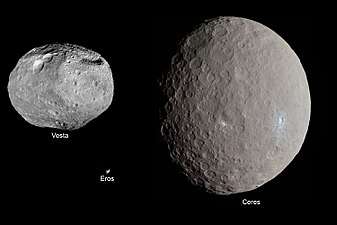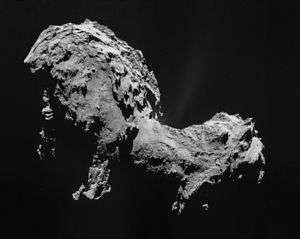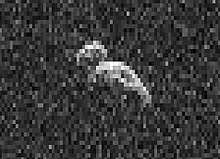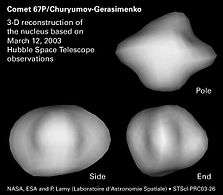PROCYON
| Mission type | Asteroid flyby, technology demonstration |
|---|---|
| Operator | University of Tokyo / JAXA |
| COSPAR ID | 2014-076D |
| SATCAT no. |
40322 |
| Website | PROCYON on University of Tokyo site |
| Spacecraft properties | |
| Launch mass | Total: 67 kg (148 lb) |
| Dry mass | 64.5 kg (142 lb) |
| Dimensions | 0.55 × 0.55 × 0.67 m (1.8 × 1.8 × 2.2 ft) |
| Power | 25 |
| Start of mission | |
| Launch date | 3 December 2014, 04:22 UTC |
| Rocket | H-IIA 202 |
| Launch site | LA-Y, Tanegashima Space Center |
| End of mission | |
| Last contact | 3 December 2015 |
| Flyby of Earth | |
| Closest approach | 3 December 2015 |
| Flyby of yet undecided asteroid | |
| Closest approach | to be decided |
PROCYON (Proximate Object Close flyby with Optical Navigation) was an asteroid flyby space probe that was launched together with Hayabusa2 on 4 December 2014 13:22:04 (JST). It was developed by University of Tokyo and JAXA. It was a small (70kg, approx. 60 cm cube), low cost (¥500 million) spacecraft.[1]
It was intended to flyby the asteroid (185851) 2000 DP107 in 2016,[2] but the plan was abandoned due to the malfunction of the ion thruster.[1]
Mission overview
PROCYON was launched as secondary payload together with the Hayabusa2 asteroid landing probe. After separation from the carrier rocket, PROCYON was left on a heliocentric orbit. On February 22, 2015, the ion engine was started, with the intention of adjusting the orbit so that an Earth flyby in December 2015 would direct the probe towards asteroid 2000 DP107.[3] Initial results were favourable - the engine delivered 330 µN of thrust rather than the designed 250 µN - but the engine failed on March 10 and could not be restarted; PROCYON flew past Earth on December 3, 2015, but was unable to make a controlled orbit change. Shortly after the Earth flyby, contact with the spacecraft was lost.[4]
The 70 kg spacecraft had a specific impulse of 1000 seconds, for a delta-V budget of about 500 ms−1; the intention was to use 20% of the xenon propellant for the initial orbit correction, and the rest of the propellant between the Earth flyby and the asteroid flyby to ensure a controlled flyby distance of 30 km.[5]
A novel subsystem tested by PROCYON involved feeding both the main ion engine and the eight cold-gas attitude control thrusters from the same tank (containing 2.5 kg of xenon at launch)
Instruments
Science results
PROCYON observed the Lyman-alpha emission of comet 67P/Churyumov–Gerasimenko to determine its overall coma structure.[7]
See also
References
- 1 2 プロキオン:小惑星への接近観測断念. Mainichi Shimbun. 8 May 2015. Archived from the original on 18 May 2015. Retrieved 8 May 2015.
- ↑ 超小型探査機「PROCYON」 二重小惑星を目指して航行中 [Very Small Probe PROCYON Cruising Toward a Binary Asteroid]. Space Elevator News. April 7, 2015. Retrieved April 7, 2015.
- ↑ "Low-thrust trajectory design and operations of PROCYON, the first deep-space micro spacecraft" (PDF).
- ↑ "On the situation of ultra small deep space explorer "PROCYON (Proquion)"". ISAS (Institute of Space and Astronautical Science). Retrieved 23 March 2018.
- ↑ "50kg- class Deep Space Exploration Technology Demonstration Micro-spacecraft PROCYON". digitalcommons.edu.
- ↑ PROCYON development team. 超小型深宇宙探査機 PROCYON(プロキオン) (PDF) (in Japanese). Retrieved May 14, 2015.
- ↑ "Micro spacecraft investigates cometary water mystery". National Astronomical Observatory of Japan. 24 January 2017. Retrieved 26 January 2017.
External links
- PROCYON on Facebook
- PROCYON website by Tokyo University (in Japanese)
- ISAS/JAXA PROCYON page
- PROCYON (PRoximate Object Close flYby with Optical Navigation) eoPortal






